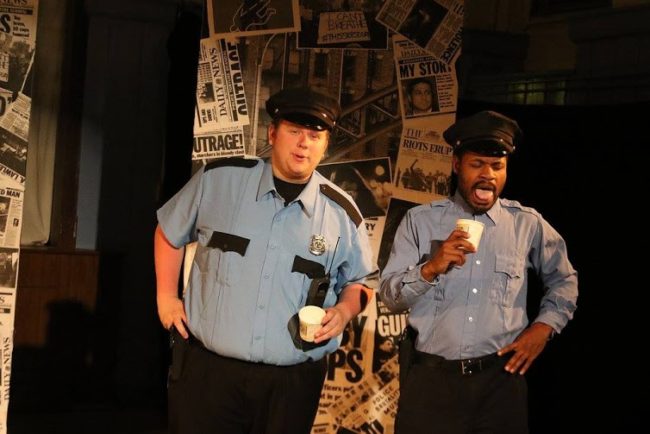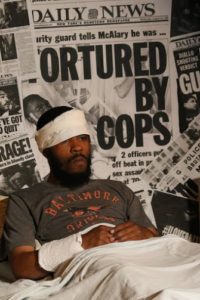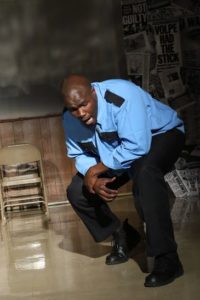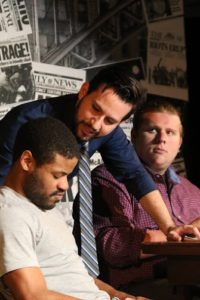Black lives matter. Blue lives matter. All lives matter. Can you address the nature of all human life being important without being effusive to one group or another or erasing the suffering that they’re experiencing when it comes to social injustice in the world where we currently live? Cohesion Theatre Company presents the penultimate production of their second season, Force Continuum by Kia Corthron, as a social examination to the current political climate— not only in Baltimore— but across the nation when it comes to dealing with the controversial topic of racial inequality and how it is placed in the system of law and order. Directed by Rosiland Cauthen, this evocative piece of theatre addresses the uncomfortable questions and starts a conversation among theatergoers about how these situations are playing out all around us every day.

Hearing about tragedies of injustice on the news is one experience. Having them happen in your home city brings the issue right to the forefront of your awareness. Scenic Designer Casey Dutt reminds the audience that Baltimore was impacted and effected only a year ago when riots broke out across the city by including the headlines of the Baltimore sun in her collage of various newspaper headlines on the upright flats that serve as scenic backdrops for the play. The design work of these flats is intentionally jarring and draws the attention of the audience to the newsworthy components of these stories by surrounding the space with their images.
The use of looped footage on the projection screen behind the play space is a powerful one. Projection Designer Nick Morrison works with Director Rosalind Cauthen to deliver maximum emotional impact at varying points throughout the production. Dash-footage of police brutality incidents, riot film footage, and other captures of these instances are used throughout the production to really drive home the reality of what we are living with. Cauthen and Morrison have a huge missed opportunity, however, near the production’s conclusion when they choose to use an interpretive dance piece set to music after a particularly emotionally evocative scene rather than finishing out with another series of projected footage. While the dance is graceful, performed fluidly by Mari Andrea, the more powerful way to capture the sentiment of that moment would have been with the reconstructive footage of peaceful protests and marches to show that there is hope for the future as we progress forward.

Cauthen’s pacing of the show is ultimately uneven. While there are a great many emotionally explosive moments that really ensnare the audience’s attention and pull theatergoers to the edge of their seats, building to those moments drags on in a sluggish fashion and lacks urgency and drive. Some of the more casual dialogue exchange scenes, written to build exposition or character detail feel out of synch with the rest of the play because they unfold without any sense of drive or movement across their action. Cauthen does, however, kick the more compelling scenes into high gear, particularly when it comes to the various outbursts achieved by the ensemble of performers.
Playwright Kia Corthron addresses a great many important topics within the play that are conversation sparkers. Some of the more prominent issues addressed— like the high rate of police suicide and the impression of guilt racial disparity causes among the police force— are penned so perfectly that it only seems natural that they would be up for discussion, and yet when they’re approached in the play it seems astounding that such topics are seldom talked about. Corthron’s work is relevant, charged with the reality of the modern world, and speaks to a large group across the board when it comes to controversial topics.

The performances featured within the production, despite the pacing, are stellar. Malcolm Anomnachi’s fury laden monologue received late in the second act is the most evocative and brutally honest moment in the performance. Without spoiling the content or sentiment behind the moment, it can be said that Anomnachi’s sense of emotional presence is awe-inspiring and harrowing, almost impossible to digest given what it is he’s speaking of. Gripping the audience with every blast of his words, Anomnachi— though his character initially appears only as a cameo— delivers a heart-wrenching scene with a great deal of energy and emotional rawness.
Dece (Terrance Fleming) who is the story’s many protagonist, delivers a great deal of his own emotional rawness, balancing this against existing in a low-key fashion. The interplay between his character and the Officer that Bobby Henneberg plays is one of the most fascinating and intricate relationships witnessed in the production. The way the pair respond to the situations and to one another shows how quickly things can get out of hand as well as how we often pick and choose our battles of injustice and inequality, carefully deciding when and how to pick a fight and over what. Henneberg does an exceptional job of playing up these moments, but it’s his moment in the bar scene that drives home yet another detrimental blow to the audience.

Fleming is a consistent dose of composure throughout the piece. His familial interactions with Grandfather (Josh Thomas) and Young Dece (Robert Highsmith) are congenial in nature and create a sharp contrast of home versus work in his portrayal of the two different faces of his character. Highsmith captures the curiously exuberant energy of a young child wishing to be like his family and join the police squad, while Thomas delivers a sagely, albeit off-kilter, elder who has wisdom and humor to dispatch.
Mrai (Mari Andrea) and Dray (Thaddeus Street) have some of the most crucial emotional interactions— both with each other as well as other characters— throughout the production. Andrea fully embodies the terror of being seized and set upon by cops in her near-delirious state while Street masterfully delivers the stalwart defiance of silence after his own encounter with the cops. Remarkable performances across the board, the piece engages the audience despite its pacing issues.
Conversations need to be had, and Cohesion Theatre Company is having them with their production of Force Continuum. There’s no better time to see it than the present as it presently addresses a great deal of the problems that we as a society are facing.
Running Time: 2 hours and 10 minutes with one intermission
Force Continuum plays through May 8, 2016 at Cohesion Theatre Company now at the United Evangelical Church— 3200 Dillon Street in the Canton neighborhood of Baltimore, MD. Tickets are available at the door or in advance online.

